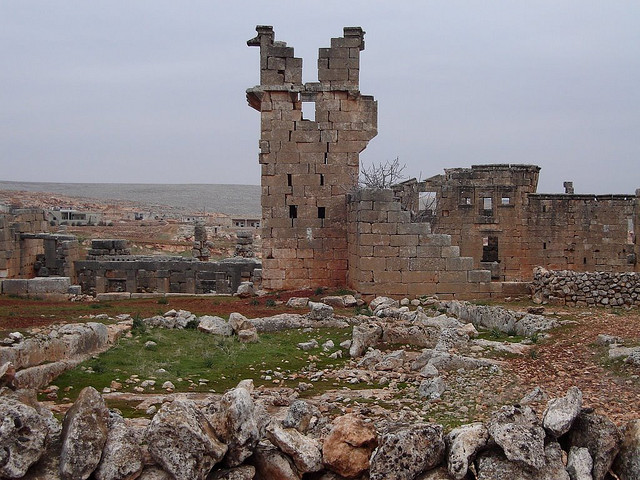Syria continues to be in the news as its government persists in its use of violence to crack down on protests inspired by the Arab Spring. It is the latest of many upheavals the country has been through since its formation as a state. In the northwest of the country are reminders of past turmoil and upheaval. Over 700 abandoned settlements bear the collective name The Dead Cities of Syria.
These abandoned municipalities scatter the landscape and contain the remains of a confident, vibrant and sophisticated culture – one which effectively disappeared over fifteen hundred years ago. Left behind, incredible and ancient structures are testament to the ingenuity and piety of the people who once lived here.
The Church of Saint Simeon Stylites is perhaps the most famous of the buildings in the area. It is the oldest Byzantine church in the world and dates back to around 475 CE. It commemorates Saint Simeon who sat atop a high pillar to preach to those who came from far and near to hear him. This vast martyrium has almost as much floor space as the Haga Sophia in Istanbul (which was, of course, then called Constantinople).
Saint Simeon's pillar is still evident, transported to the church after his death. Yet over the many centuries, pilgrims have chipped away at it for souvenirs until the pillar now is little more than a boulder.
Between the cities of Aleppo and Hama there is a limestone massif and it is here these ancient settlements were built by their once prosperous peoples. The area is about thirty kilometers in width yet is several times longer – extending to almost 140 kilometers in length. It isn’t hard, considering this thin, long concentration of settlements to divine the reason for their presence – trade!
The names of the cities are numerous: Jaradeh, Telanissos, al-Bara, Surkania, Dar Qita, Ruweiha, Surkania. All are silent witness to a civilization now vanished in to the footnotes of history. Their importance is somewhat blithely underestimated by modern locals who still pick around them, occasionally plant small olive groves among the ruins - and even climb them (go back to the fourth photograph!).
Trade brought in gold and silver, which was used to fund the building of this exquisite Christian Byzantine architecture. The ethnic makeup of the citizens of these cities would have been diverse, as is so often the case on a trade route. Yet the practiced religion of the cities’ populations seems to have been overwhelmingly Christian. A great many of the surviving buildings are churches.
The nature of the settlements has been a matter of debate for many years. Some argue that these forgotten cities were built by a prosperous and thriving peasant class which slowly strung out its line of influence. It is true that there are very few specifically urban features along the length of the settlements although sturdy domestic architecture has weathered the centuries well.
Others argue that these were, indeed, cities rather than a string of peasant collectives. The main produce of the area was olive oil and the international demand for this valuable product would have ensured an infrastructure comparable to other thriving towns and cities towards the end of the era of antiquity.
Serjilla and Bara, the best preserved of the cities, would seem to support this opinion. There is a bath house in the former, always a sign the prosperity of a city and was built around 470 CE when Christianity was well established. There is also a meeting place for men, a kind of Byzantine gentleman’s club where important decisions would be made. Its main source of income was grapes and olives, grown in the fertile soil of the natural basin in which it was built.
Bara, on the other hand, seems to have been a military base. Perhaps for this reason it survived longer than the other cities. It was conquered by crusaders in 1098 and taken back by Muslim forces thirty years later. It was a severe earthquake later in the twelfth century which forced its eventual abandonment. Bara’s retention of population is unusual in the area.
One thing is for sure: the inhabitants of most of these lost cities packed up and left slowly but surely in the sixth and seventh centuries. The area had been conquered by the Arabs and this meant that trade routes shifted. Warfare did not do for these incredible settlements but economics. The population declined and dwindled to the point that the cities were eventually deserted.
It is almost comforting to reflect that despite its post apocalyptic appearance, the denizens of these places, the original names of which are long forgotten, were not put to the sword. Rather they headed towards more prosperous cities along newer trade routes, there to settle hopefully in peace. They left behind their churches, homes, meeting places - and their dead.
As the Arab Spring began in early 2011 the dead cities of Syria became a UNESCO World Heritage Site. Tourism to Syria is at the moment effectively suspended but when civil stability returns the local people around the dead cities will resume giving those willing to go off the beaten track a warm welcome.










































No comments:
Post a Comment
Note: Only a member of this blog may post a comment.